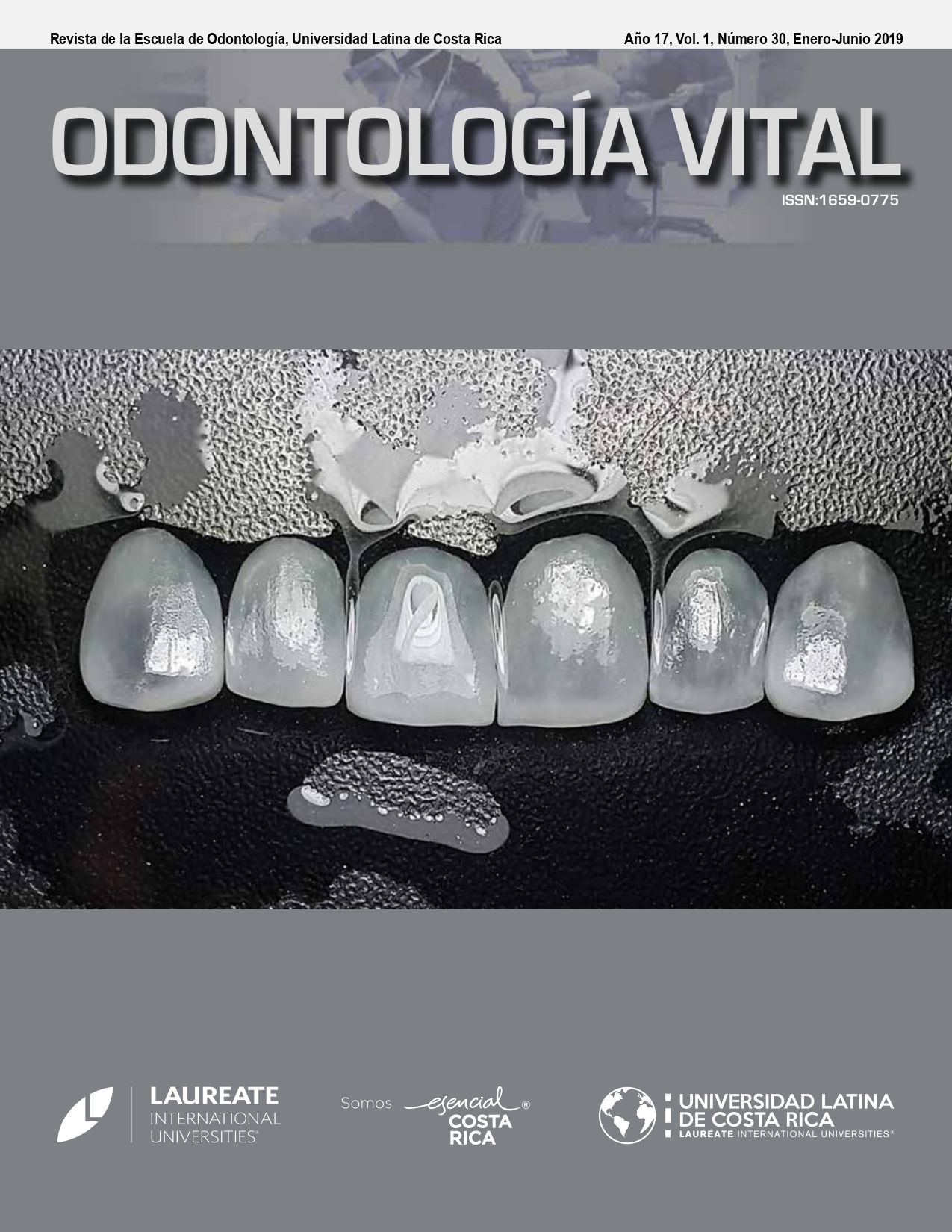Color stability of flow composite resins after contact for 30 days with two gaseous beverages: in vitro study
DOI:
https://doi.org/10.59334/ROV.v1i30.138Keywords:
Gaseous beverages, color, weight, composite resinsAbstract
Objective: Evaluate the color stability of three flow composite resins, by a digital colorimeter after contact for 30 days with soft drinks.
Materials and methods: 21 discs of 8 mm diameter and 2 mm thickness were constructed with flow Alpha, Brilliant, Wave and Opallis resin, the color evaluation was performed by digital colorimeter and the weight with precision balance, after contact in distilled water for 24 hours. The discs were subdivided into four subgroups (n = 7) and submerged for 30 days in 10 ml of Coca-Cola, Fanta or artificial saliva, after a new evaluation of color and weight was performed. The data was analyzed by the Kruskal Wallis, Wilcoxon, Anova and Tukey statistical tests.
Results: Alpha Flow resin showed greater resistance to color variation after 30 days in contact with the gaseous beverages evaluated, Coca-Cola showed greater color modification in materials, without significant difference between initial weight and the final weight between the materials.
Conclusions: Alpha Flow resin showed greater stability to the color change, Coca-Cola was the gaseous drink with greater influence in the color change; No changes in weight.
Downloads
References
Ada Council on Scientific Affairs. Direct and indirect restorative materials. JADA, 2003; 134: p. 463-472. https://doi.org/10.14219/jada.archive.2003.0196
Alpha Flow. Dental Technologies. [Online]; 2014. Disponible en: http://www.dentaltech.com/alpha-flow.html
Batra, R., Kataria, P., Kapoor, S. (2016). Effect of Salivary pH on Color Stability of Different Flowable Composites – A Prospective In-vitro Study. Journal of Clinical and Diagnostic Research; 10(10): p. ZC43-ZC46. https://doi.org/10.7860/JCDR/2016/21584.8641
BRILLIANT™ NG Coltene. Simplemente natural. [Online]; 2014. Disponible en: http://www.coadental.com/uploads/Archivo345.pdf
Caramori, V., Schmitt, V., Rucker, M., Pinceli, L., Pardo, F. (2014). Sistemas de pulido de un o múltiples pasos de resinas compuestas hibridas y su alteración en la estabilidad del color y rugosidad superficial. Acta Odontológica Venezolana; (1)52.
Chalacán, R., Garrido, P. (2016). Análisis comparativo del grado de pigmentación de tres resinas nanohíbridas. Revista Facultad de Odontología; p. 62-72.
Ertas, E., Guler, A., Yucel, A., Koprulu, H. (2006). Color stability of resin composites after immersion in different drinks. Dent Mater J; 25: p. 371-376. https://doi.org/10.4012/dmj.25.371
Guler, A., Yilmaz. F., Kulunk, T., Guler, E., Kurt, S. (2005). Effects of different drinks on stainability of resin composite provisional restorative materials. Journal of Prosthetic Dentistry; 94(2): p. 118-124. https://doi.org/10.1016/j.prosdent.2005.05.004
Hervás, A., Martínez, M., Cabanes, J., Barjau, A., Fos, P. (2006). Resinas compuestas. Revisión de los materiales e indicaciones. Medicina Oral, Patología Oral y Cirugía Bucal; (11)2.
Lafuente, D., Abad, K. (2014). Influencia de Bebidas Gaseosas en la Integridad de Márgenes en Restauraciones de Resina Compuesta. Odovtos International Journal of Dental Sciences;(16): p. 115-123.
Malekipour, M., Sharafi, A., Kazemi, S., Khazaei, S., Shirani, F. (2012). Comparison of color stability of a composite resin in different color media. Dent Res J; 9(4): p. 441-46.
Malespin, K., Molina, C. (2016). Estudio in vitro sobre la estabilidad del color de tres resinas directas UAM: 1: p. 14-21.
Moharamzadeh, K., Van Noort, R., Brook, I., Scutt, A. (2007). Analysis of components released from dental composites with different resin compositions using different extraction media. J. Mater Sci. Mater Med; 18: p 133–137. https://doi.org/10.1007/s10856-006-0671-z
Opallis Flow. FGM Estética. [Online]; 2017. Disponible en: http://www.fgm.ind.br/site/produtos/estetica-es/opa-llis-flow/?lang=es
Ríos, D., Honório, H., Francisconi, L., Magalhães, A., De Andrade, M., MA. B. (2008). In situ effect of an erosive challenge on different restorative materials and on enamel adjacent to these materials. J- Dent; 36(2): p. 152-7. https://doi.org/10.1016/j.jdent.2007.11.013
Rodríguez, G., Douglas, R., Pereira, S., Natalie, A. (2008). Evolución y tendencias actuales en resinas compuestas. Acta Odontológica Venezolana; 46(3): p. 381-392.
Rodríguez, G., Douglas, R., Pereira, S., Natalie, A. (2008). Evolución y tendencias actuales en resinas compuestas. Acta Odontológica Venezolana; 46(3): p. 381-392.
SDI. Wave Flow. [Online] 2015. Disponible en https://www.sdi.com.au/downloads/instructions/INST_SHEET_WAVE.pdf
Sosa, D., Peña, D., Setién, V., Rangel, J. (2014). Alteraciones del color en 5 resinas compuestas para el sector posterior pulidas y expuestas a diferentes bebidas. Revista Venezolana de Investigación Odontológica; 2(2): p. 92-105.
Soto, J., Lafuente, D. (2013). Efectos de las bebidas gaseosas sobre algunas resinas compuestas. Revista Científica Odontológica; 9(2): p. 9-15.
Tekçe, N., Tuncer, M., Demirci, M., Serim, C., Baydemir, J. (2015). The effect of different drinks on the color stability of different restorative materials after one month. Restorative Dentistry and Endodontics; p. 255-261. https://doi.org/10.5395/rde.2015.40.4.255
Downloads
Published
Issue
Section
License
Copyright (c) 2019 Lidia Consuelo Arcos Tomalá, Víctor Alfonso Montaño Tatés, Ana del Carmen Armas

This work is licensed under a Creative Commons Attribution 4.0 International License.
Authors who publish with Odontología Vital agree to the following terms:
- Authors retain the copyright and grant Universidad Latina de Costa Rica the right of first publication, with the work simultaneously licensed under a Creative Commons Attribution 4.0 International license (CC BY 4.0) that allows others to share the work with an acknowledgement of the work's authorship and initial publication in this journal.
- Authors are able to enter into separate, additional contractual arrangements for the non-exclusive distribution of the Odontología Vital's published version of the work (e.g., post it to an institutional repository or publish it in a book), with an acknowledgement of its initial publication.
- Authors are permitted and encouraged to post their work online (e.g., in institutional repositories or on their website) prior to and during the submission process, as it can lead to productive exchanges, as well as earlier and greater citation of published work.







